
-- A Cyberspace Review Of The Arts
Volume 17.26
November 29, 2010
|
Self-Destroying Art by Gordon Fitch You can't really see it any more, of course, because by now most of the works have destroyed themselves, although they might let you in to examine the detritus. But on November 6th, Flux Factory, in Long Island City, gave an exhibition of self-destroying art. Plenty of art destroys itself unintentionally, or is intentionally destroyed by someone other than the art or the artist, but art that destroys itself deliberately goes back to the early days of the Dada movement with its emphasis on irrationality and chaos -- at a time when what we might call the Square World was paying strict attention to the constuctiveness, rationality and order of World War I.
Flux Factory is, indeed, a factory of sorts. It seems to have been a small one of the more conventional sort, on 29th Street in an area known to Long Island City cognoscenti as Dutch Kills, just north of the 59th Street Bridge and up the hill a bit from the East River. I will not go into its institutional history, as this is available on the Web at their web site and is further described in Queensbuzz. I did ask one of the perpetrators if they were descended from or connected with the famed Fluxus of New York City's 60's and 70's, other than in spirit, but no one I spoke to was willing to admit to it. The actual destruction was slated to begin at 6 p.m., but according to Nonsense New York the show's doors opened at 11 a.m. I managed to saunter in at a less barbaric 5 p.m. when most of the works or installations had been set up, and a few had already had time to malfunction, jumping the gun, so to speak. I confess I had some vague idea that I might find something like a Survival Research Labs performance (in which robotic machines destroy not themselves but each other, and sometimes go after members of the audience), but in accordance with the continental East-West paradigm Flux Factory proved more thoughtful and Dadaistic and less like an action movie.
After fortifying myself at the wine and crackers counter I moved around the space, having unwittingly already trod upon one of the exhibits, a chalk drawing on the entrance hallway which destroyed itself by offering itself to the footsteps of the show's visitors. Going by the map which I secured from one of the staff, this might have been Douglas Paulson's 'Homage To Homage's Ephemera, Which Outlived The Rest' -- or not. It was later photographed bracketed with illuminated umbrellas and other photographic apparatus by people with bigger cameras than mine.
The first person I spoke to was John Roach, whose rather elaborate work was called 'The Sweet Sweet Sound of Self-Destruction.' Like many of the pieces on display in this show, some intervention by the artist was required to get the destruction going, so what we had was a combination of an installation and performance art. The center of the piece was a record player sitting on a table in what appeared to be a cheap motel room, constructed as two walls, one with a window through which a suitably lurid red light was thrown. On the other wall were several clear vinyl records containing an eight-minute collage of the works of 36 self-destructive artists, such as Jimi Hendricks, Darby Crash, Modest Mussorgsky, Charlie Parker, Kurt Cobain, and so on. There were also small effigies in paper of the musicians. In the performance, the effigies were hung over the tone arm of the record player (one of the old, 78-rpm, windup kind) and burned as the record played. The burning debris fell on the records, eventually making them theoretically unplayable. Mounted over the record was a small video camera that captured the record's originally clear surface as it quickly became encrusted with ash. The procedure was captured by a video camera and presented on a television knocked on its side on the carpeted floor. The detritus (somewhat burned records, and so on) was later made available for sale. During the time I attended the show this was certainly one of the most popular events.
Further along the wall was a automated hammer which beat on a jar of bright yellow paint whenever anyone approached it -- part of it was an electronic circuit detecting the presence of an observer -- in front of a white board. It did not look to me as if anything was going to be destroyed -- I encouraged it to no avail -- and indeed the name of the work, by Ben Dierckx, was 'The Color That Will Probably Never Make It To The Canvas.' Beyond that was a large dragon or dinosaur, made of pipes, cables, bicycle parts and so forth which could be driven, so to speak, so that it would wave its head about and gnash its impressive, Jurassic-Park-style beak, but it did not seem willing or able to destroy things or to fall apart of its own accord. This piece, too, was very popular. Finally on this side of the room there was a sort of Barbie-Doll chamber with large aluminum-foil prisms hanging in an otherwise mostly pink environment. I was told that this piece, too, had to be destroyed by the artist, Angela Washko, but I did not see this occur. On the other side of the room was a secret chamber housing a black-and-white movie, by Kerrey Downey and Cladia Salinas, called 'Yesterday, Once More'. I made a movie of movie myself which is about the only way it can be described. Near that was a work by Dana Sherwood, called 'House Mouse House', containing a number of mice eating the work, which had the form of a small house or perhaps a cubical cake in the form of a small house. The mice were doing a good job of destroying it, but I was somewhat worried about their retirement benefits, which might require fees for a visit to a mouse fat farm.
Beyond that was a very complex construction called 'Unseating/De-nesting'. It did look like a large nest of sorts, but of some kind of very baroque and shiny creature -- a phoenix, perhaps? Over it were balloons in rings from which were hanging bunches of feathers. Clearly, when the balloons lost enough air, the feathers would fall upon the nest and do something destructive to it; but I was not able to find out what that something was. The next construction was a series of three paintings by Daupo, called 'Sweet' in which water dripped through three regular paintings on muslin or some other light cloth, producing a fourth painting below them by dissolving away the pigments of the first three and depositing them on the fourth. In the corner, by Brendan Coyle, there was 'Soap Pyramid', a model of an Egyptian-style pyramid made with cakes of Ivory Soap, upon which a hose ending in a series of sponges meditatively dripped water. Clearly there was a play in the work between the transitory nature of a pyramid of soap under a stream of water and the relatively permanent character of the objects it modeled, which have been around for several thousand years. The hose itself also self-destroyed a bit as it was set up, giving the work a certain unexpected character, but it was eventually forced to obey.
Diagonally across from this work at the other end of the room was a semi-enclosed space with checkered walls (inspired by the Checkered Demon of yesteryear? Who remembers the Checkered Demon?) -- and a device emitting wandering rays of green LED light which I was told are now standard equipment in clubs. The installation was attributed to someone who goes by the moniker of 'Ghostfuk3r'. The room contained a pile of hopefully cheap electric guitars; at some point in the evening these were to be smashed in old-time rock style with the amplifiers and speakers running full blast. Heard smashed guitars are sweet, but those unheard are sweeter, and the room was filling up, so at this point I gave in to my resident ochlophobia and departed the scene. I eagerly await the next effort there; in fact, I might go back sooner to see how things have succeeded in deteriorating. Flux Factory's next event, on December 15, at Center 548, 548 West 22nd Street, New York, NY 10011, is a silent auction; see http://www.fluxfactory.org/art4sale/ to get an idea of what's being offered. "Doors open at 7pm, auction ends at 10pm, with performances and dancing to follow." |
||||||||||||
|
|
||||||||||||
|
|
||||||||||||
|
Gordon Fitch |
||||||||||||
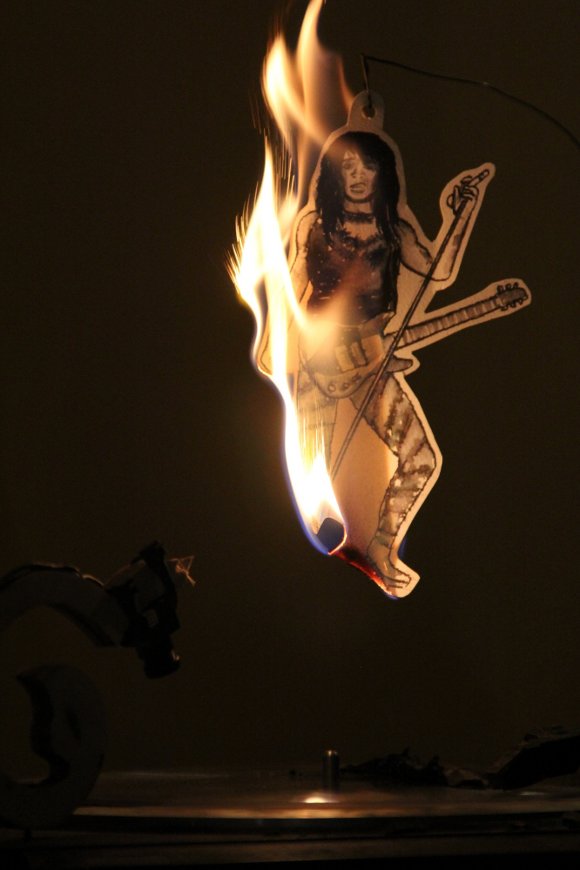
 Probably the most famous work of this kind in history
was
Probably the most famous work of this kind in history
was 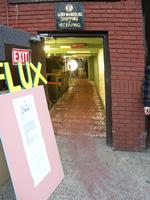



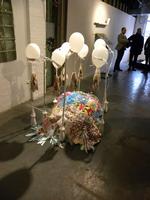
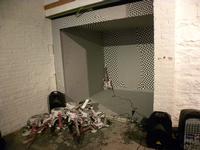
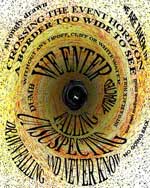
 Back to the Front
Back to the Front